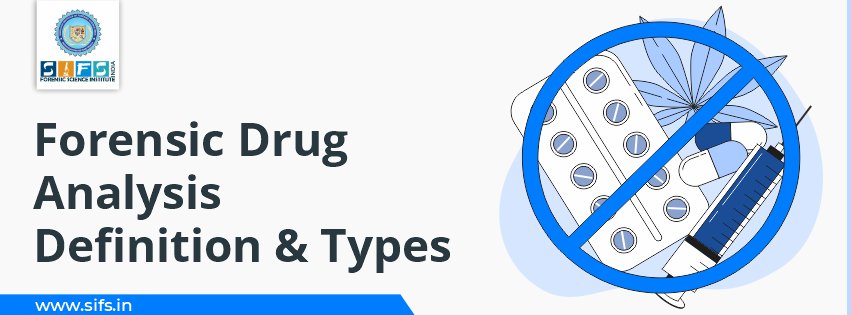- Call Us: +91 7303913002
- Email Us: education@sifs.in
Forensic Drug Analysis | Definition and Types

BY SIFS India | January 06, 2025
Forensic Drug Analysis | Definition and Types
Forensic Drug Analysis deals with the identification and quantification of illegal drugs that are in use.
It is used in the determination of drugs in hospitalized patients that are admitted due to suspected poisoning, drug-facilitated crimes, driving with drugs, and usage of drugs in human performances such as sports.
What is a Drug?
According to the World Health Organization, a drug can be defined as “any substance that is used or proposed to be used to modify or explore physiological structures or pathological states for the benefit of the recipient”.
A drug can also be defined as a substance that is not considered as a food or food supplement that has the ability to cause a medicinal, intoxicating, performance augmenting, or another abnormal effect when taken into the human or animal body.
The definition of drugs may vary depending on the various drug control laws, government regulations, medicinal purposes, or on the basis of their usage.
Types of Drugs
Drugs can be classified into two types based on their usage. They are;
- Therapeutic drugs
- Psychoactive drugs
Therapeutic Drugs
Therapeutic drugs have healing or preventive properties with regard to certain diseases. It can also be administered to help in certain medical diagnoses. The drugs that are commonly used in therapeutics can be classified into four main categories. They are;
Analgesics and Antipyretics: An analgesic is a type of drug that is used to relieve pain whereas an antipyretic is a type of drug that is used to reduce the body temperature.
Antihistaminic agents: A drug that is commonly used in allergic disorders as well as other conditions like the common cold.
Antidepressants: A drug that is used in psychiatric disorders for the treatment of endogenous depression
Tranquillizers: A drug used to reduce tension and anxiety of mental patients.
Psychoactive Drugs
Psychoactive drugs which are also known as the psycho-pharmaceutical or psychotropic drug is a chemical substance that mainly acts upon the central nervous system affecting brain function which results in modification of perception, mood, consciousness, cognition, and behavior.
They can be used recreationally for changing one’s consciousness or for ritual or spiritual purposes. They can also be used for the treatment of psychiatric disorders.
These psychoactive drugs are extensively used regardless of the consequences and health risks.
Many governments worldwide have imposed restrictions on the production of drugs and their sales in an attempt to decrease drug abuse and its misuse.
The world’s largest psychoactive substance that is consumed is caffeine. However, this is unregulated and legal in almost all judiciaries, unlike other drugs that are being used.
The most common psychoactive drugs used are; Narcotics, Stimulants, Hallucinogens, Depressants, and Anabolic steroids.
Usage of Drugs in the Community
Approximately about 6.6% of the adult population that is aged between 15 to 64 years use drugs with much greater percentages.
Even though most of these users are not involved in criminal activities, approximately 10% of the drug users have developed either a drug dependency syndrome or other drug use disorders and interact with the legal system.
In some authorities over 70% of individuals are arrested for illicit drug usage or drug trafficking.
It is observed that premature diseases and injuries are also higher in drug users and a certain percentage of deaths are caused due to illicit drug usage.
Due to the usage of various drugs around the world, drug testing laboratories are very important and the diversity, as well as the scale of the substances, should be considered by analysts in forensic investigations.
Forensic drug analysis surrounds many related disciplines that involve different types of analytical techniques whereas the results obtained could be used in legal proceedings.
Drug Analysis Procedures From Forensic Chemist Perspective
Initially, the drugs should be accurately weighed during the collection process.
This includes weighing the drugs together with the packaging material and recording the weights. However, there is an exception if the collected drugs are in liquid form.
These types of drugs are measured in liters, milliliters or other metric units that represent volume.
If the drugs are collected in individual dosage forms, like pills or tablets, or if they are packaged separately in packets, each dosage should be counted.
In situations where there are many identical units of a drug, investigators may weigh 100 units of the drug and then divide that weight by 100 to estimate the weight of an average unit. Hence, all units could be weighed together, dividing that weight by the individual unit’s weight to estimate the total number of units.
After the collection is done, the collected evidence should be preserved or stored in an appropriate way. Some substances are placed in sealed envelopes while some are placed in airtight and watertight plastic containers.
Liquid substances could be kept in their original containers, assuming they are tightly sealed or they can even be placed in other appropriate containers like sealed conical tubes to minimize vaporization.
The challenging task in forensic drug identification is selecting the suitable analytical procedure for the identification of a specific drug. There are two main types of analysis used in determining whether an illegal drug is present. They are; presumptive analysis and confirmatory analysis.
Presumptive Analysis
Presumptive analysis which is also known as preliminary test or screening test is a test that is nonspecific and preliminary in nature.
It is used in the general screening to classify substances into a general category to indicate that an illegal substance may be present.
Common presumptive analysis methods are; color spot test, microscope analysis, and microcrystalline analysis.
Color Spot Test
This is a presumptive identification technique that indicates the presence or absence of a particular drug class using rapid and uncomplicated chemical methods. When a test chemical is added to an unknown substance the chemical will react and change color accordingly if the drug is present.
Table 1- Color spot test identification
| Reagent | Positive Result | Possible Drugs Present |
Marquis | Purple,
| Heroin, Morphine and most opium derivatives. A mixture of Amphetamines and Methamphetamines. |
| Dillie-Koppanyi | Violet-Blue | Barbiturates |
| Duquenois-Levine | Purple | Marijuana |
| Van Urk | Blue-Purple | LSD |
| Scott Test | Blue | Cocaine |
Microscope Analysis
This involves the visual inspection of the general structure of the substance. The objective of using this method is to provide a broad classification. This analysis method is typically used for larger material sizes like plant materials.
Microcrystalline Analysis
This involves the addition of a drop of a chemical reagent to a small quantity of the drug which results in the formation of crystals. Viewing these crystals with the help of polarized light can help in the determination of their structure. This technique is considered to be more specific compared to color tests. There are many crystalline tests that have been developed for the identification of the most commonly used drugs.
Confirmatory Analysis
This involves the identification of the substance and it often continues from where a presumptive test has been left off.
Generally, this includes a multi-step process for the separation of individual compounds and for the determination of their chemical characteristics, comparing them against the available reference materials to make a positive identification.
This is known as qualitative analysis and it can be used to determine the substances that are present and whether these substances are illegal.
However, the confirmatory analysis may also include qualitative analysis when determining the amount or purity of the illegal substance depending on the lab requirements. For this qualitative and quantitative analysis of drugs, various methods such as Thin Layer Chromatography, Mass Spectrometry, and Infrared Spectroscopy are used.
Thin Layer Chromatography
This involves a solid stationary phase which is usually coated onto a glass plate and a mobile liquid phase for the separation of mixtures. In this technique, when the solvent travels up the chromatogram, components of the mixture travel at different speeds and using this, unknown substances can be compared to reference samples.
Mass Spectrometry
This is an analytical method that utilizes ionization and mass analysis of compounds for the determination of the mass formula and the structure of the analyzed substance. Mass spectrometry provides information regarding the molecular mass and the isotopic abundance of elements and temporally resolved chemical data enabling a highly accurate identification.
Infrared Spectroscopy
This is the analysis of infrared light interacting with a molecule. It involves the passing of a light beam through a substance and recording the amount of light that is transmitted through that substance. The light that is not transmitted is considered to be absorbed by the substance.
Conclusion
The ultimate goal of forensic drug analysis is to ensure that the collected evidence is legally accepted as evidence in a court of law.
Therefore, it is the responsibility of the investigator to make sure that the quality of the drug evidence is maintained from its time of collection until it is presented as evidence in court.
Forensic drug analysis is concerned with the identification of illegal drug samples that are bought to the lab pertaining to a case. Therefore, in this field, it is important that practitioners maintain awareness with regard to the substances that are emerging in a forensic and a general medical context.
Written by: Buddhini Tharushika Tennakoon

